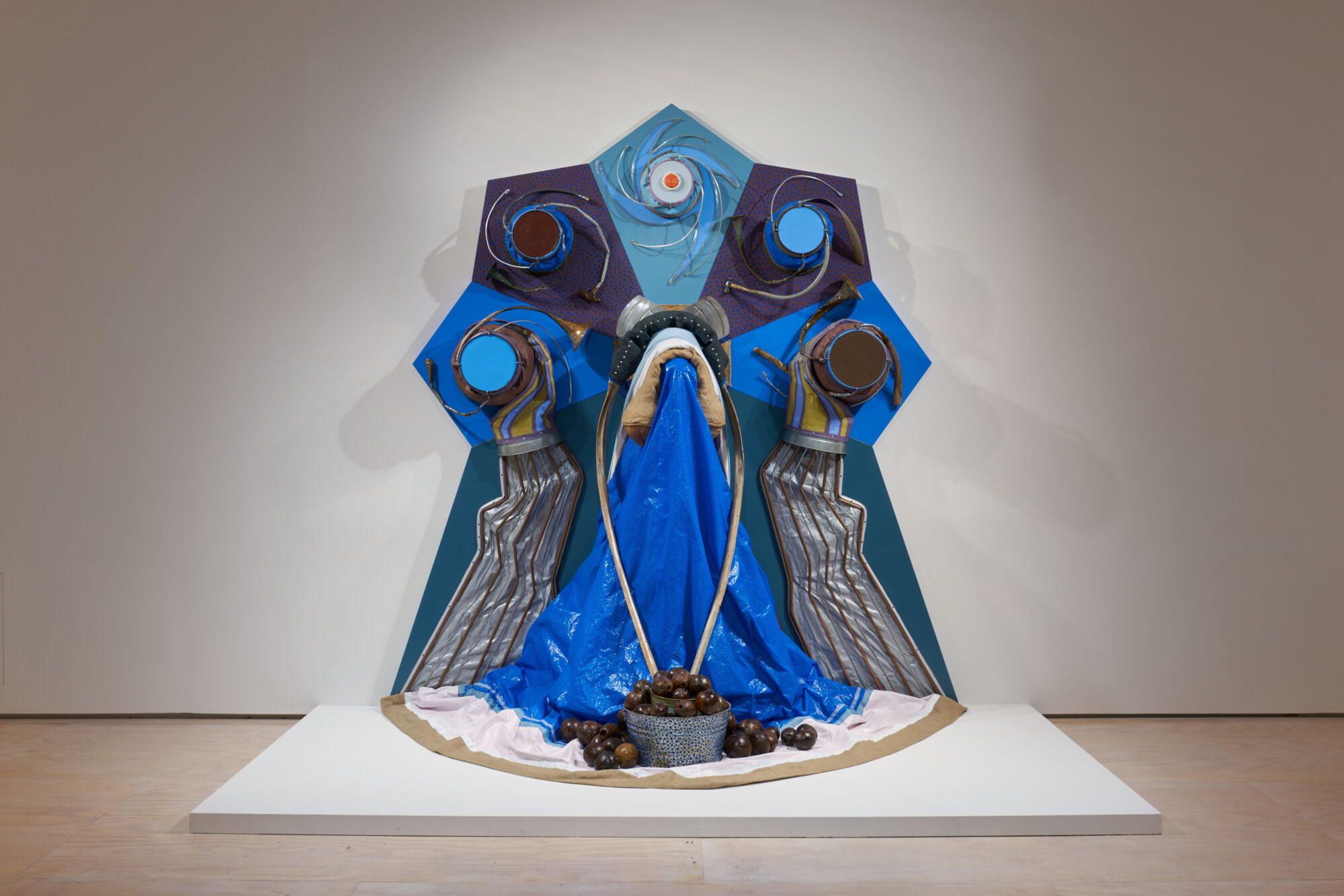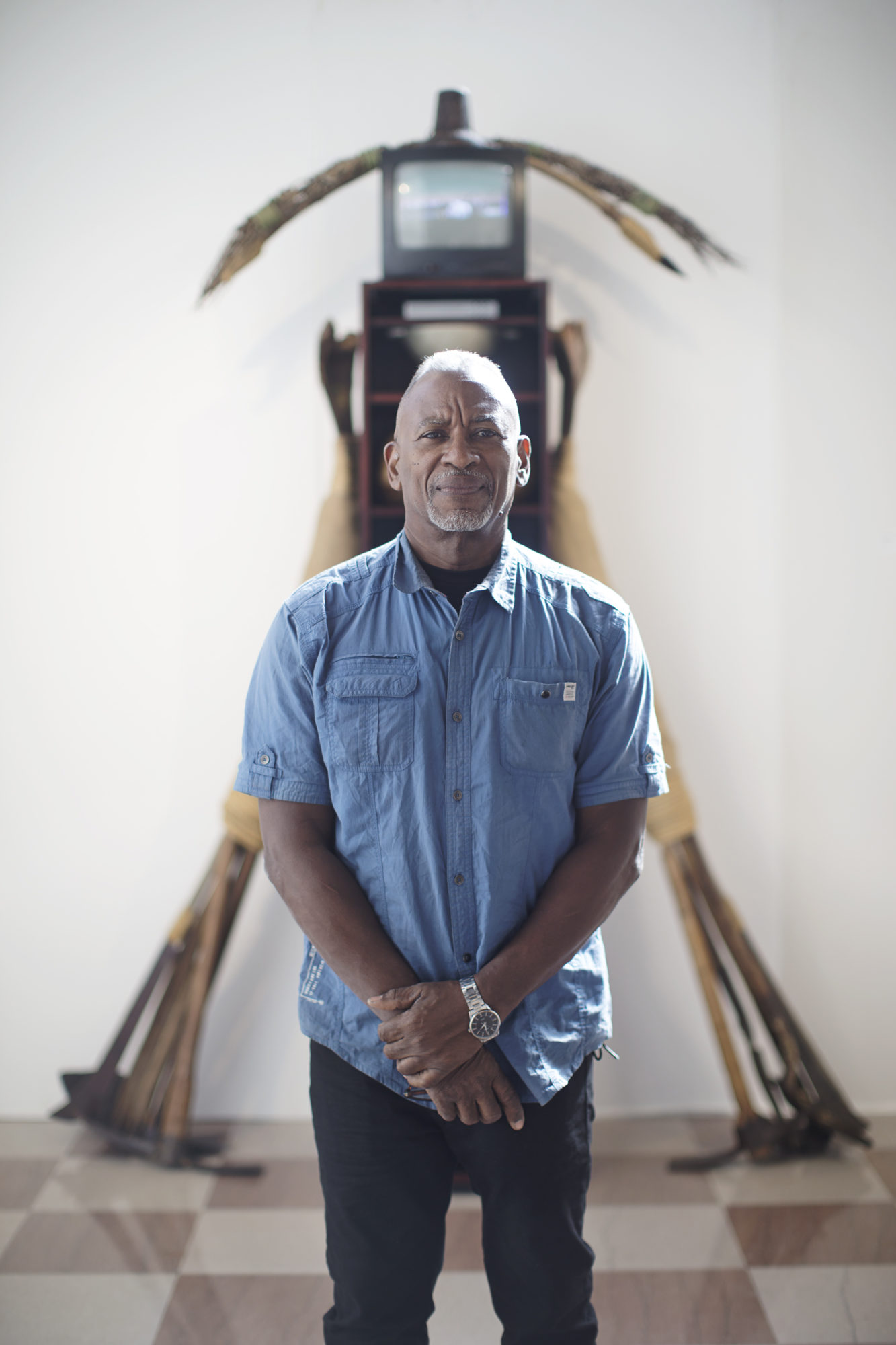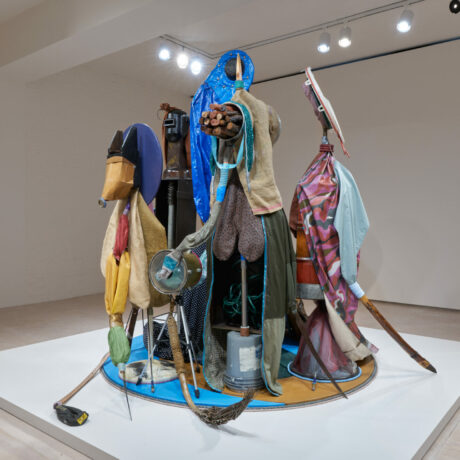At MoMA PS1, Daniel Lind-Ramos’s powerful exhibition offers a powerful ode to community resilience and memory filtered through the lens of Loiza’s annual festival.
New York – Daniel Lind-Ramos’s sculptures are vessels for memories: in his works, histories, both personal and shared, are presented through a healing and liberating lens. Loíza, Puerto Rico, where he lives and works today, is at the heart of his practice. Each intricate, large-scale assemblage is an ode to resilience as seen through the lens of coastal hometown, which was originally settled by members of the West African Yoruba tribe after they were freed from slavery.
In Lind-Ramos’s work, frenetic dots of paint, swaths of colourful fabric, and found objects frozen in motion carry multitudes: the sounds of the festival, folktales passed down for generations, seasonal rain and wind and thunder, and bomba: Puerto Rico’s musical fusion of Taíno, West African and Spanish influences.
Lind-Ramos draws from the distinct and joyful aesthetic of Loíza’s annual multi-day festival, Fiestas de Santiago Apóstol, to reclaim stories that have either been erased, sanitised, or forgotten from over five centuries of Afro-Puerto Rican culture and history. “I am filtering what you see through the aesthetic of the carnival,” says Lind-Ramos, noting how recounting anecdotes from the past year is a festival tradition.
“Lind-Ramos draws from the distinct and joyful aesthetic of Loíza’s annual multi-day festival, Fiestas de Santiago Apóstol, to reclaim stories that have either been erased, sanitized, or forgotten from over five centuries of Afro-Puerto Rican culture and history.”
A procession of archetypal festival characters weave through the floor plan of Lind-Ramos’s current solo show at MoMA PS1, “Daniel Lind-Ramos: El Viejo Griot — Una historia de todos nosotros (The Elder Storyteller — A Story of All of Us).” Every summer, when the artist was a child, he would decorate a cardboard mask and dress up as the festival’s viejo (or storyteller) to parade through town alongside his friends and family. Here, he embodies the storyteller while also paying homage to his community’s African roots. “I wanted to make a link between the two customs, so I added Griot to the name,” he explains, adding, “In Western Africa, the griot is a person who tells stories.”
The exhibition opens with an eponymous sculptural assemblage: the viejo griot personified by the bow of a boat flanked with an assortment of objects found by Lind-Ramos or gifted to him by his community — a plastic lid, hat, gloves, conga drum, cardboard, tambourine, coconuts, rope — and red, yellow, and green cargo sacks stamped with numbers that recall significant dates in Puerto Rican history.
The numbers reference the indigenous Taíno Rebellion against Spanish colonisers in 1511, the spring of 1797 when the British navy was defeated by the Black militia of Partido de Loíza, and 1980: the year Puerto Rican police officers murdered Adolfina Villanueva Osorio, a young mother who was killed in front of her home for protesting an unlawful eviction. “It’s very important to recognise these historical facts, not only for my community, my town, my country, but also for the Caribbean in general, and then at the end, global history, because we are talking about the British army; we’re talking about history in general,” says Lind-Ramos as he recounts stories behind the numbers scattered throughout the work.
Around the corner, the sound of jazz momentarily trickles in from a small room that is playing a recording of Talegas de la Memoria, 2020, a happening that the artist directed on the Vacía Talega beach of Loíza. On the screen, self-liberation unfolds through moving, improvised performances by members of the artist’s community as they reconcile with the town’s past traumas of colonialism and the transatlantic slave trade. Outside of the frame, locals gather around to watch the event.
“My intention was to include my friends that work on the beach to confront them with the history of the place,” says Lind-Ramos. “I use art as an instrument to confront my community with certain stories that I think are important to know. When I was a child, there were a lot of historical facts where our ancestors were involved that we were not informed about in school.”
While Lind-Ramos’s work chronicles the experiences of his immediate community, he emphasises global relevance. The artist doesn’t believe in fixed meaning. His shapeshifting sculptures invite multiple interpretations depending on perspective. “What country hasn’t experienced invasion, catastrophe, slavery?” he asks.
“The stories embedded in Lind-Ramos’s practice, whether they are about victories or tragedies, the natural world or human nature, all reverberate with messages of resilience and the transformative power of memory. “I remember,” his works seem to say, “and by remembering, I reclaim the power of my ancestors and the earth.”
The stories embedded in Lind-Ramos’s practice, whether about victories or tragedies, the natural world or human nature, all reverberate with a message of resilience and the transformative power of memory. “I remember,” his works seem to say, “and by remembering, I reclaim the power of my ancestors and the earth.”
Like the viejo, the artist himself is a gifted storyteller with an expansive memory of his country’s history. He speaks poetically and emphatically, making wide gestures with his arms as he agilely walks around his towering works, their construction a feat of the artist’s physical strength and community support.
At 70 years old, Lind-Ramos manages to possess the boundless wonder of a child and the wisdom of an elder whose memories trace back to days before Loíza had electricity. He bought the town’s first colour TV with money from his scholarship from the University of Puerto Rico, a scene alluded to in an earlier work in the exhibition: Armario de la Memoria, 2012, in which a TV monitor rests atop a tall wooden cabinet framed by shovels and machetes. “There is an object in each work that activates my memory, my imagination, and from there I depart,” he says.
Lind-Ramos paints with objects; his background studying painting is present in the clever and moving ways he uses colours in his assemblages. The blue Federal Emergency Management Agency (FEMA) tarp that appears throughout his practice is a nod to the omnipresent role of the waterproof sheets in the aftermath of the devastating Hurricane Maria as well as the metaphorical qualities of blue.

“You could relate the FEMA tarp to water and the sea. It could be the sky. But who owns the sky? Who owns the sea?” he says. “The blue could suggest water that belongs to the United States in terms of the political situation in Puerto Rico…it could suggest a lot of things.” One particular tarp used in his twenty-three-part Maria series, Baño de María (Bain-marie/The Cleansing), 2018–2022, was given to him by a neighbour after Hurricane Maria.
The artist often finds discarded objects during his regular walks along Loíza’s coast. The lace-up brown leather boots in Ambulancia, 2020, lean forward under the weight of an abstract ambulance carriage. “I find a lot of shoes on the shore, shoes that vary in size, children’s shoes,” says Lind-Ramos. “I often wonder if those shoes belong to migrants that have been lost at sea. I remember that they must have belonged to a human being and that we don’t know what happened to them,” he adds.
Lind-Ramos worked on Ambulancia during the throes of peak covid anxiety when he was still in New York; Central Park was transformed into a makeshift tent hospital, and havoc reverberated throughout the world. (His two daughters are both nurses who worked through the pandemic.) The destruction of Hurricane Maria, the unidentified shoes of migrants lost at sea, and the lives taken by the pandemic push up against each other, drawing out universal themes of loss; Lind-Ramos was thinking of the apocalypse.
“I was thinking about the lack of beds, the collapse of the health system in the whole world, the absence, the empty chair, the empty bed, people dying,” he says. Yet, for all of the tragedy contained in the work, there is a prevailing sense of hope and healing: an ecosystem of care formed by community support efforts that rise up when all else fails.
The presence of community is a throughline in Lind-Ramos’s work. “They think of my studio as an extension of the community,” he says of the locals. He often holds community events where he invites his friends to interact with his works and share their own. It is not uncommon for someone to pop in to observe the artist’s latest work or bring found objects for him to use. Musician friends pass along hand-me-down instruments like the trumpets that coil around Baño de María; Neighbours entrust him with well-used tools like a yucca grater given to him by a retired cook named Emma in Figura Emisaria (The Emissary), 2020.
“While Lind-Ramos’s work chronicles the experiences of his immediate community, he emphasizes a global relevance. The artist doesn’t believe in fixed meaning”
“I remember when I showed this sculpture for the first time,” he says as he stands in front of a glass food display case holding Emma’s grater fringed by lacquered palm tree fronds. The artist recounts the event he held at the house he was born: “I placed many tables in the yard and invited members of the community. I invited a young cook, poets. The cook cooked; the poets read poetry about food. People talked about what their ancestors used to cook. At the end, I invited the members of Emma’s family to bring the grater and place it there, like this,” he gestures to the relic. “The sculpture was activated by members of the community.”
As we walk through his exhibition, Lind-Ramos shares memories that span from recent years to his youth spent exploring Loíza’s Pinones Mangrove Forest to fish and forage for sansevieria o lengua de vaca (snake plant or cow tongue), a plant his mother used to make natural fibre. Now, he regularly ventures through the wet forest floors in search of debris, branches, and divine inspiration.
“My first encounter with visual art was in my house.” He recalls his childhood home, with a foundation made of palm trees, that bustled with creative energy. “My uncle was a mask-maker, my mother was a seamstress, my grandmother was a seamstress, and my other uncle was a cabinet-maker.”
The first sculpture Lind-Ramos made as a child was a mask carved from a coconut shell, a method passed down from his uncle. Today, he uses his uncle’s brushes and knives as well as his other uncle’s cabinet-making tools.
Growing up around artists and craftsmen was formative for the artist. “I would wake up in my house and see everyone doing something, and I wanted to do something too, so they allowed me to draw on the walls,” he laughs.
Now, Lind-Ramos works to instil that sense of creativity in his community. “When you’re a child, you see possibility in everything,” he emphasises. “I still remember those drawings. They gave me the freedom to express myself, and that freedom remains with me today.”
Words by Meka Boyle

Daniel Lind-Ramos: El Viejo Griot — Una historia de todos nosotros (The Elder Storyteller — A Story of All of Us)” runs through Sept. 4 at MoMA PS1
FIND OUT MORE






